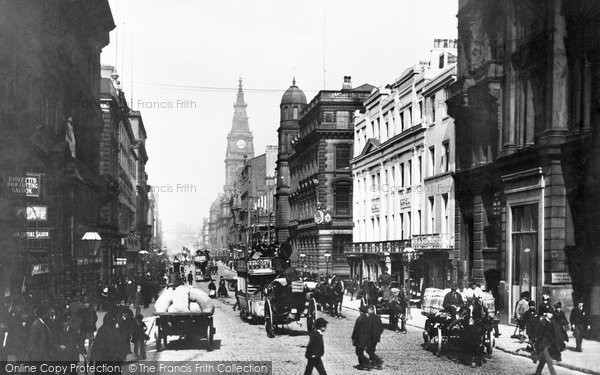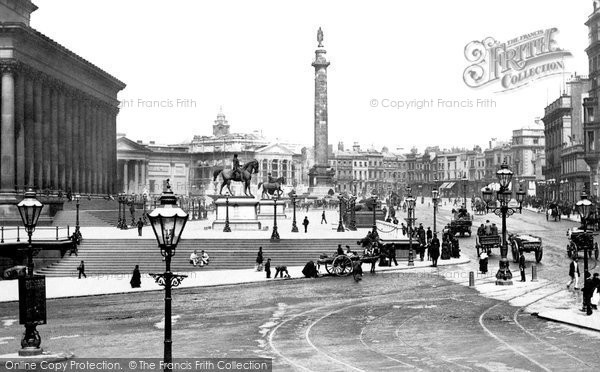Liverpool History
The history of Liverpool and specially selected photographs
'Gateway to the British Empire', 'Second City in England', 'Door to the New World'. All these titles have been used to describe the city of Liverpool. Around two hundred years ago it was a creek in the river; at the start of the 1900s Liverpool had built itself up into a world-class city with seven miles of docks full of ocean-going ships.
Liverpool was born thanks to a charter from King John in 1275. He promised land and equality to all who moved there, and thus the wonderful mix that makes up the people of Liverpool was started. It is a proud city, and an independent city; a city whose leading figures have upheld its proud traditions, and whose population included an unusually high number of philanthropists - together they forged a city of world-wide renown.
In the 19th century Liverpool would have had upwards of two hundred ships every week leaving for every corner of the great British Empire, and indeed the world. Ships went to Canada for corn, and carried iron goods to South America and Africa, and railway carriages to Brazil and South Africa. Ships loaded with generators and electrical goods for Australia and New Zealand brought wool and mutton back. India, China and Japan, Egypt - everywhere on the globe was covered by ships from Liverpool.
As the 19th century drew to a close, Liverpool was an exciting, vibrant city. Its citizens forged ahead with great building projects and modernisation. They electrified the Mersey Underground Railway, and they built an Overhead Railway to connect the ever-expanding dock area. Shipping companies built citadels that matched their world status. Insurance companies, whose fortunes waxed or waned with the fortunes of those shipping companies, vied with each other to build the grandest offices in the city centre.
Started in June 1838 to accommodate the Liverpool Music Festival, which was held every four years and had become a very popular event, St George's Hall is one of the greatest buildings in England. The designer Harvey Longsdale Elmes was only 23 when he won the design competition, firstly for the Music Hall and then for new Law Courts for Liverpool; he put the two buildings into one. Because of the change of plans and uses of the hall, the building was not started in earnest until 1842. Elmes never saw his magnificent work completed. The extra work put such a burden on him that he fell ill, and was sent on a sea journey to the West Indies to rest. He died just after arriving in Jamaica, and is laid to rest there. His work was taken over by C R Cockerell. The hall was opened on 18 September 1854. It is a strange mixture - concert hall, law courts, theatre, cells and jail - but it worked well, and is a marvellous and unique building.
Statues of Raphael and Michelangelo stand on the entrance steps to the Walker Art Gallery in William Brown Street. Opened in 1877 to the design of H H Vale, it was built as a single-storey Grecian-style building. The bas-relief friezes along the front of the building represent four royal visits to Liverpool. From right to left, beginning in Mill Lane, they show the embarkation of King William III and his army at Hoylake in 1690; continuing in William Brown Street are King John granting the first Charter to the burgesses of Liverpool in 1207, the visit of Queen Victoria in 1851, and the laying of the foundation stone of the Walker Art Gallery by the Duke of Edinburgh in September 1874. On the roof over the main entrance to the Gallery is an allegorical statue of Liverpool, by John Warrington Wood. The large female figure in Carrara marble is seated on a bale of cotton, crowned with a laurel wreath and holding a trident in one hand, and a ship's propeller in the other.
The William Brown Library, with its fine portico of six Corinthian columns, was built in 1860 to house the natural history collection of the 13th Earl of Derby; this had been bequeathed to the town in 1851. William Brown was a wealthy merchant who offered to pay for much of the cost of this grand enterprise, and he was rewarded for his generosity with the street and library named after him. There was much celebrating, and a day's holiday for the townspeople, when the building opened; it was the first of a magnificent row of public buildings in this street. It was badly bombed in 1941 and was rebuilt behind the original Grecian frontage.
The Picton Library and Reading Room was named after Sir James Allanson Picton, antiquary and architect, knighted in 1881, who was the first chairman of the Liverpool Libraries Committee. He had devoted himself to the foundation of a free public library and museum for the people of Liverpool. The architect of this lovely round building was Cornelius Sherlock, and it was built between 1875 and 1879. Liverpool people nick-named it 'the gasometer', and the name stuck for many years. The building was provided by Sir William Brown, and the Corporation later added the Picton Reading Room in 1879.
'The Three Graces of Liverpool' is the affectionate name given to a group of Pier Head buildings that is believed by many to be one of the most imposing waterfront views in the world - the Royal Liver Building, the Cunard Building and the Port of Liverpool Building. The Royal Liver Building must be one of the most recognisable buildings in Great Britain. Started in 1908, it was one of the world's first multi-storied buildings using re-enforced concrete for its construction. It was finished three years later in 1911. It was designed by Aubrey Thomas in a very free style, with the two mythical Liver Birds perched on the top of its towers. The Liver Birds are made of hammered copper plates bolted together, and are 18ft high. Their wingspan is 12ft across. They were made by a man named George Cowper, who was backed by the Bromsgrove Guild; once they were satisfied with their work, they dismantled the statues and rebuilt them on top of the Liver Building, fixing them into place with a rolled steel armature and 25ft of girders. No-one is exactly sure what the mysterious stone Liver Birds really represent. They may be cormorants or even griffins, but it is generally believed that their name is derived from the ‘lyver’ seaweed that they grasp in their bills.
Over the years, the great liners have gone, and the river front is quiet. Containerisation, mechanisation, in fact a whole new world is now taking over; but instead of going into a decline, Liverpool is once more thriving in a different way, and rising to new challenges that lie ahead. Liverpool today is one of the country's most successful and promising cities.
Further Reading
To discover the histories of other local UK places, visit our Frith History homepage.
Liverpool History in Photos
More Liverpool PhotosMore Liverpool history
What you are reading here about Liverpool are excerpts from our book Liverpool and Merseyside Photographic Memories by Cliff Hayes, just one of our Photographic Memories books.







